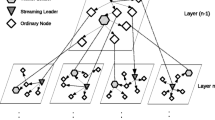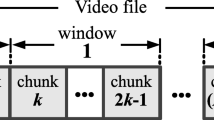Abstract
This paper investigates how a p2p television platform can take advantage of the presence of frequent channel viewers to grant them a more satisfying service than to less regular spectators, and how such privileged users can also be protected when unfavorable operating conditions manifest within the overlay. The explored idea is to learn beforehand about the users’ interests, monitoring their behavior in the recent past, in order to cluster them in groups that display different habits; then, the video chunk scheduling algorithm of the overlay is altered, with the aim of serving frequent spectators in a privileged manner, providing them with a better viewing experience and a faster access to the selected channel without overly penalizing less habitual customers. An analytical model is developed, to capture the difference in average startup delay that the proposed modifications introduce; several additional performance metrics are numerically determined, in order to thoroughly size up the performance of both groups of viewers. The obtained results show that a clear service differentiation is attained and demonstrate that, if bandwidth resources become scarce, frequent viewers are protected and still enjoy a broadcasting service of superior quality.











Similar content being viewed by others
References
Beconn. http://www.beconn.com
PPTV Homepage. http://www.pptv.com
TUDOU Hompage. http://www.tudou.com
Meridian node to node latency matrix (2500×2500) (2005) Meridian Project. www.cs.cornell.edu/People/egs/meridian/data.php
Bezdek JC (1981) Pattern recognition with fuzzy objective function algorithms. Plenum Press, New York
Chang C-Y, Chou CF, Chen KC (2014) Content-priority-aware chunk scheduling over swarm-based p2p live streaming system: From theoretical analysis to practical design. IEEE J Emerg Sel Topics Circ Syst 4(1):57–69
Dunn JC (1973) A fuzzy relative of the isodata process and its use in detecting compact well-separated clusters. J Cybern:32–57
Guha S, Rastogi R, Shim K (2001) Cure: an efficient clustering algorithm for large databases. Inf Syst 26(1):35–58
Kaufman L, Rousseeuw P (1998) Finding groups in data: an introduction to cluster analysis. Wiley & Sons, New York
Kleinrock L (1975) Queueing systems, vol. I: theory. Wiley Interscience
Li B, Xie S, Qu Y, Keung G, Lin C, Liu J, Zhang X (2008) Inside the new coolstreaming: principles, measurements and performance implications. In: IEEE INFOCOM 2008. The 27th Conference on Computer Communications
Liu F, Li B, Li B, Jin H (2013) Peer-assisted on-demand streaming: Characterizing demands and optimizing supplies. IEEE Trans Comput 62(2):351–361
Manzato D, da Fonseca N (2013) Providing fast channel switching in p2p iptv systems. IEEE J Sel Areas Commun 31(9):326–337
Merani M, Saladino D (2010) Live video and ip-tv. In: Shen X et al (eds) Handbook of peer-to-peer networking. Springer(US)
Natali L, Merani M, Barcellona C (2014) An interest-aware video streaming platform: shaping its architecture to better suit users’ demands. IEEE ICME Work Multimed Affect Comput:1–6
Natali L, Merani M, Barcellona C (2014) Leveraging users’ likes in a video streaming p2p platform. IEEE INFOCOM Workshop on Communication and Networking Techniques for Contemporary Video:269–274
Ramachandran K, Sikdar B (2010) A queuing model for evaluating the transfer latency of peer-to-peer systems. IEEE Trans Parallel Distrib Syst 21(3):367–378
Suh K, Diot C, Kurose J, Massoulie L, Neumann C, Towsley D, Varvello M (2007) Push-to-peer video-on-demand system: design and evaluation. IEEE J Sel Areas Commun 25(9):1706–1716
Thomos N, Chakareski J, Frossard P (2011) Prioritized distributed video delivery with randomized network coding. IEEE J Emerg Sel Topics Circ Syst 13(4):776–787
Wu C, Li B (2007) Diverse: application-layer service differentiation in peer-to-peer communications. IEEE J Sel Areas Commun 25(1):222–234
Wu D, Liu Y, Ross K (2010) Modeling and analysis of multichannel p2p live video systems. IEEE/ACM Trans Netw 18(4):1248–1260
Zhang M, Zhang Q, Sun L, Yang S (2007) Understanding the power of pull-based streaming protocol. IEEE J Sel Areas Commun 25(9):1678–1694
Author information
Authors and Affiliations
Corresponding author
Appendices
Appendix I
It is first assumed that the system of Fig. 3 is non empty: conditioning upon such event, Fig. 12 allows to conclude that the only observable interdeparture time coincides with the service time of a high interest customer. Hence the conditioned Laplace transform Φ∗(s) of the p.d.f. of time d is
If the system is empty, Fig. 13 indicates that the interdeparture time is given by the sum of two independent random variables: irrespective of the type of customer who will get into service, the first is a residual interarrival time, exponentially distributed with parameter λ = λ H + λ L , the second is a service time, so that
Unconditioning with respect to the server status, which is idle with probability p 0 and busy with probability 1 − p 0, Φ∗(s) expression as appearing in Eq. (13) is attained.
Appendix II
For the system whose state diagram appears in Fig. 3, consider \(t_{s_{H}}\), the time spent in system by a high interest customer, and recall that \(S^{\ast }_{H}(s)\) indicates the Laplace transform of its p.d.f. Conditioning upon the number k found in system upon the arrival of the high interest customer, when k = 0\(t_{s_{H}}\) is the service time of the high interest customer; when k = 1, it is the residual service time of the customer found in service upon the arrival plus one service time; for k ≥ 1, it is one residual service time plus k full service times, each exponentially distributed with parameter μ, so that the conditional Laplace transform of \(t_{s_{H}}\) p.d.f. is
unconditioning with respect to k, \(S^{\ast }_{H}(s)\) is determined as
and replacing p 0 and p k , k ≥ 1, as provided by Eqs. 11 and 12 in 34, after some standard, algebraic passages \(S^{\ast }_{H}(s)\) turns out to be
where c 1 and c 2 expressions appear in Eq. (27) of Section 4.
Rights and permissions
About this article
Cite this article
Merani, M.L., Natali, L. & Barcellona, C. An IP-TV P2P streaming system that improves the viewing quality and confines the startup delay of regular audience. Peer-to-Peer Netw. Appl. 9, 209–222 (2016). https://doi.org/10.1007/s12083-014-0323-x
Received:
Accepted:
Published:
Issue Date:
DOI: https://doi.org/10.1007/s12083-014-0323-x






